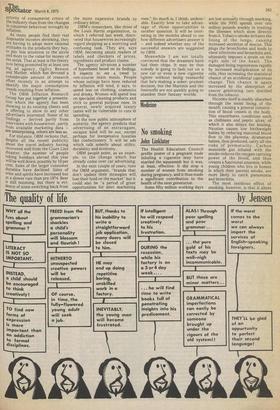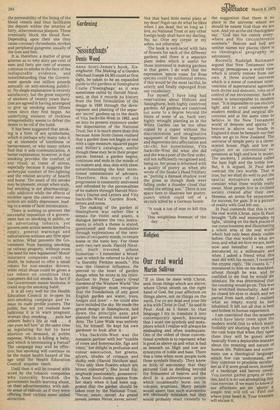Medicine
No smoking John [Animater
The Health Education Council profile poster of a pregnant nude inhaling a cigarette may have startled the squeamish but it was, at least, effective. It did stop a number of women from smoking during pregnancy, and it thus made a significant contribution to the health of the next generation.
Some fifty million working days are lost annually through smoking, while the NHS spends over one, million pounds weekly in treating the illnesses which stem directly from it. Tobacco smoke irritates the lining of the lungs, causing increased secretion of mucus. This plugs the bronchioles and leads to chest infections and bronchitis and, ultimately imposes a strain on the right side of the heart. The damaged lining regenerates rapidly by increased multiplication of its cells, thus increasing the statistical chance of an accidental cancerous change. This chance is again increased by the absorption of cancer generating tars distilled from the tobacco.
Nicotine itself is readily absorbed through the moist lining of the mouth, causing a general constriction of blood vessels in the body. This exacerbates conditions such as chilblains and peptic ulcer, of which it also delays the healing. Nicotine causes low birthweight babies by reducing maternal blood flow to the placenta; dysmature babies, thus produced, carry all the risks of prematurity. Carbon monoxide gas inhaled with the smoke reduces the oxygen carrying' power of the blood, and thus creates a functional anaemia, while young children who live in homes in which their parents smoke, are more likely to catch pneumonia and bronchitis.
The most insidious effect of smoking, however, is that it alters
the permeability of the lining of the blood vessels and thus facilitates the deposit within the arteries of fatty, atheromatous plaques. These eventually block the blood flow. Depending upon their site they cause coronary thrombosis, strokes and peripheral gangrene, usually of the toes and feet.
It is, therefore, a matter of great interest as to why sixty per cent of men and forty per cent of women continue to smoke in the face of the indisputable evidence, and notwithstanding that the Government spends one million pounds annually on anti-smoking publicity. No single explanation is entirely satisfactory, but the great majority of smokers of twenty years duration are agreed in having attempted to give up smoking some fifteen times since they first began. An underlying element of reckless irresponsibility seems to defeat the desire to be rid of the habit.
It has been suggested that smoking is a form of sex symbolisms, which is perhaps why many take it up at moments of loneliness or bereavement, or why many others find that it aids communication. A better explanation, however, is that smoking provides the comfort, of arty ritual, at times of stress, especially because it suggests the archetypal comfort of fire-lighting and the related security of hearth and home. The smell of the smoke may be pleasant, except when stale, but smoking is not pharmacologically addictive while the effects of nicotine upon the central nervous system are mildly depressant, leading to a sense of faint intoxication.
There is nothing to prevent the successful imposition of a government ban on smoking in public, or on advertising tobacco, yet govern.nent action seems limited to empty, general warnings and exhortations without any firm spur to action. What prevents the Government from banning smoking on railway property, without even the need for new legislation? Motor insurance companies could, no doubt, be induced to offer a small rebate for non-smoker drivers, while retail shops could be given a tax rebate on condition that customers did not smoke. In fact if the Government meant business, it could stop the smoking habit.
It is all very well for the Health Education Council to re-open its anti-smoking campaign and reissue its nude profile posters. The public has not yet realised how ludicrous it is to warn pregnant woman that smoking. . . puts her unborn baby's life at risk . . it can even kill him" at the same time as legislating for her to have abortion on demand, at public expense. Which is killing a baby, and which is terminating a foetus? The campaign may well be effective, but smoking will continue to be the major health hazard of the age until the Health Education Council acquires teeth.
Until then it will be treated with scorn by the tobacco companies who cynically brandish the government health warning about, on their advertisements, with subtle sense of ridicule, as if they were offering their victims some added attraction.











































 Previous page
Previous page